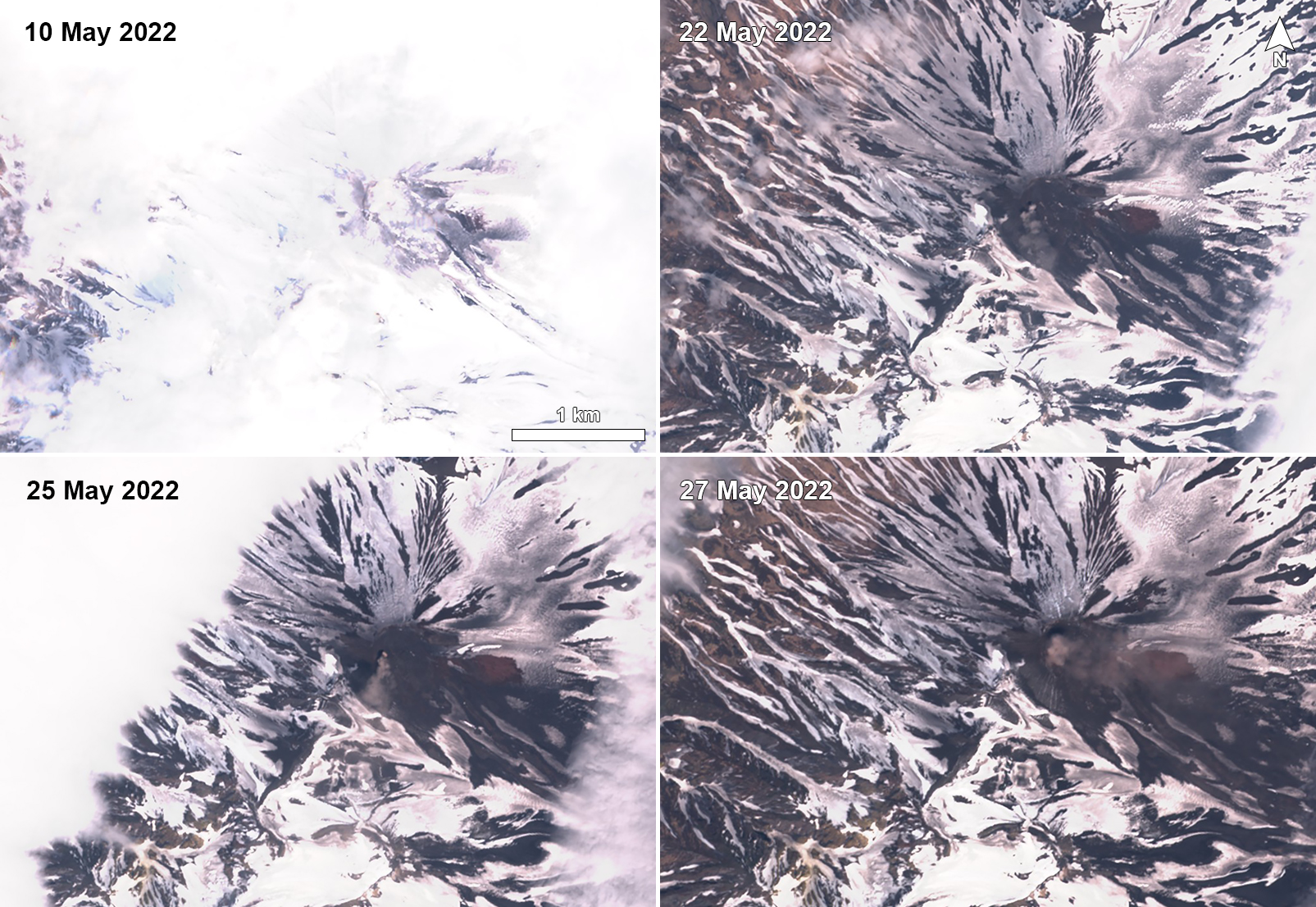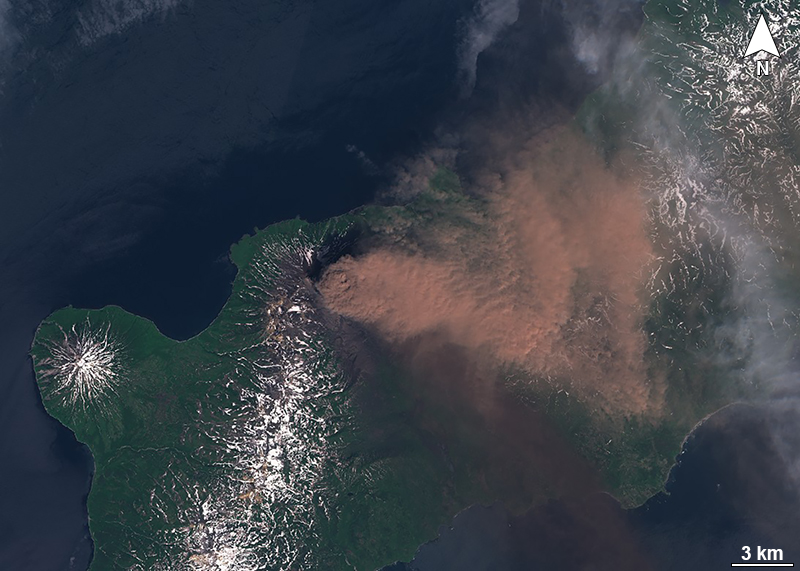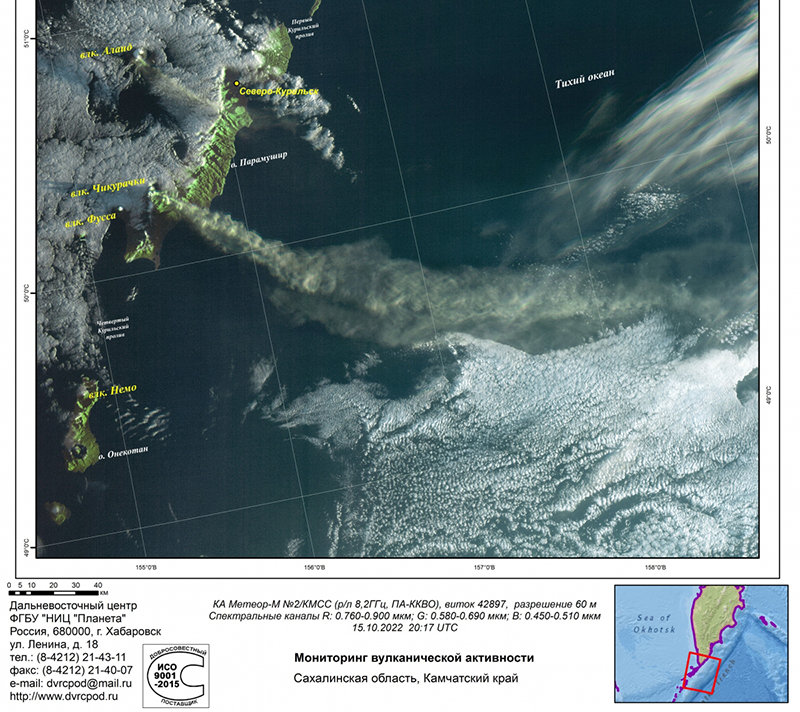Report on Chikurachki (Russia) — November 2022
Bulletin of the Global Volcanism Network, vol. 47, no. 11 (November 2022)
Managing Editor: Benjamin Andrews.
Edited by Kadie L. Bennis.
Chikurachki (Russia) Occasional explosions, ash plumes, and thermal anomalies during May-October 2022
Please cite this report as:
Global Volcanism Program, 2022. Report on Chikurachki (Russia) (Bennis, K.L., and Andrews, B., eds.). Bulletin of the Global Volcanism Network, 47:11. Smithsonian Institution.
Chikurachki
Russia
50.324°N, 155.461°E; summit elev. 1781 m
All times are local (unless otherwise noted)
Chikurachki is the highest volcano on Paramushir Island in the northern Kuriles. It is a small cone constructed on a high Pleistocene edifice. Reported eruptions date back to 1690, with the most recent eruption period beginning in January 2022 that consisted of ash explosions, ash plumes, thin ash deposits on the flank, and thermal activity (BGVN 47:05). This report covers activity during May through October 2022 characterized by occasional explosions, ash plumes, and thermal anomalies. Information primarily comes from the Kamchatka Volcanic Eruptions Response Team (KVERT), the Tokyo Volcanic Ash Advisory Center (VAAC), and satellite information.
No activity was reported during May through the first half of June 2022. Sentinel-2 satellite imagery captured some dark brown to black ash deposits near the summit and flanks of the volcano on 5, 7, 10, 17, 22, 25, 27, and 30 May (figure 15). Possible gas-and-steam emissions containing some ash were visible on 22, 25, and 27 May.
A thermal anomaly was first identified in satellite imagery on 21 June. KVERT reported that an explosive eruption began around 0730 on 24 June; explosions were recorded during 0730-2100 (local time), which generated ash plumes that rose to 4.5 km altitude and drifted 45 km SE (figure 16). The large ash cloud was visible in satellite images at 0850 and drifted 25 km SE (figure 17). A VONA (Volcano Observatory Notice for Aviation) that was issued at 1445 on 25 June stated that only gas-and-steam emissions were rising from the volcano. The ash cloud from 24 June had drifted about 790 km SE by the next day. Another explosive eruption was reported on 30 June at 1230. The resulting ash plumes rose to 4.5 km altitude and drifted 300 km W and 50 km SSE. A thermal anomaly was also reported over the area on 30 June. Ongoing ash plumes rose to 3-4.6 km altitude and drifted E through 1 July, based on satellite data, according to the Tokyo VAAC. Activity declined by 1230 on 1 July. During 2-5 July only gas-and-steam emissions were visible, according to KVERT. Sentinel-2 satellite imagery captured gray plumes on 1, 4, and 11 July (figure 18). No further activity was reported for the remainder of the month.
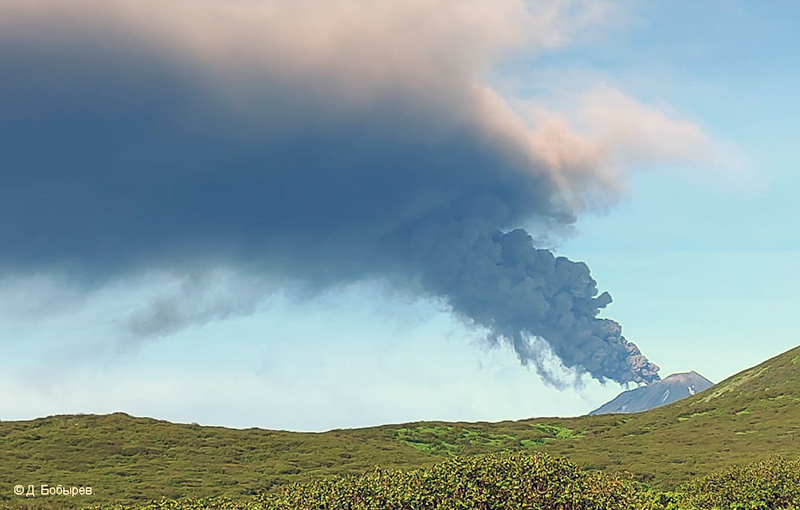 |
Figure 16. Photo of a strong ash plume rising to 3 km altitude and drifting SE from Chikurachki at 0730 on 24 June 2022 (local time). Photo has been color corrected. Courtesy of D. Bobyrev, KVERT. |
The first half of August was similarly quiet; a single plume was visible on 5 August that drifted NW from the summit crater, based on a Sentinel-2 satellite image. Observers reported that on 22 August an ash emission rose to 2 km altitude and drifted E (figure 19). During 23-25 August occasional ash plumes rose as high as 2 km altitude and drifted as far as 20 km E and 8 km SE. A thermal anomaly was detected in satellite images on 25 August. On 26 August an ash plume drifted 94 km ESE. Activity during September declined and became relatively low again. According to the Tokyo VAAC, an ash plume that was identified in satellite images rose to 3.7 km altitude and drifted NE at 1730 on 2 September. A thermal anomaly was visible on 4 September. Gas-and-steam emissions continued to be detected at the summit crater.
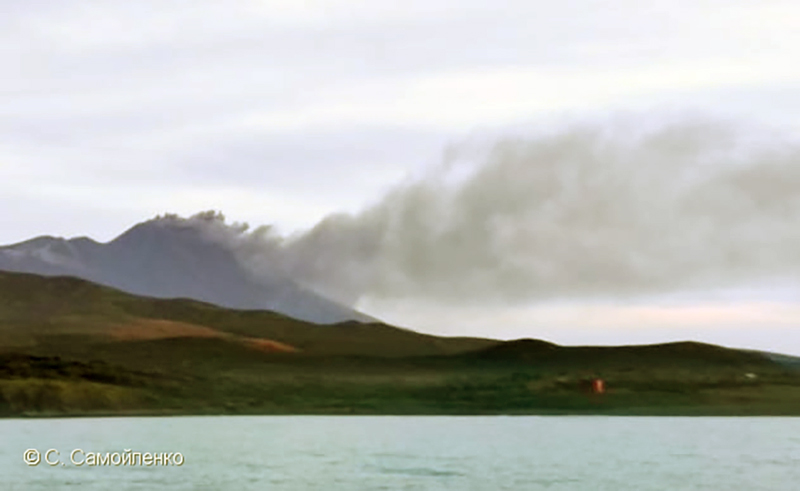 |
Figure 19. Photo of ash emissions rising from Chikurachki and drifting E on 22 August 2022. Courtesy of S. Samoylenko, KVERT. |
Gas-and-steam emissions persisted during October and two explosive eruptions were reported. An explosive eruption began around 0310 on 16 October. Satellite images showed a dense ash plume rose to 4.3-4.6 km altitude and drifted 240-344 km ESE (figure 20). A thermal anomaly was also visible in satellite data. At 1011 and 1620 that same day ash plumes rose as high as 3.5 km altitude and drifted ESE; by 1620 ash plumes had extended as far as 523-780 km (figure 21). Ongoing ash emissions rose to 4.3 km altitude on 17 October and drifted SE, according to the Tokyo VAAC. KVERT reported that ash emissions were last observed at 0130 on 17 October and a thermal anomaly was visible at 0432.
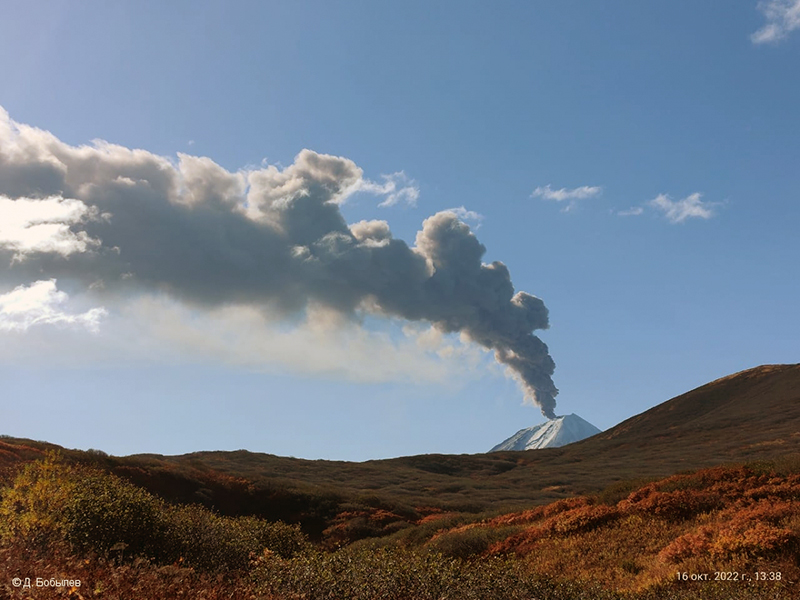 |
Figure 21. Photo of a strong ash plume rising above Chikurachki on 16 October 2022. Photo has been color corrected. Courtesy of D. Bobylev, KVERT. |
Geological Summary. Chikurachki, the highest volcano on Paramushir Island in the northern Kuriles, is a relatively small cone constructed on a high Pleistocene edifice. Oxidized basaltic-to-andesitic scoria deposits covering the upper part of the young cone give it a distinctive red color. Frequent basaltic Plinian eruptions have occurred during the Holocene. Lava flows have reached the sea and formed capes on the NW coast; several young lava flows are also present on the E flank beneath a scoria deposit. The Tatarinov group of six volcanic centers is located immediately to the south, and the Lomonosov cinder cone group, the source of an early Holocene lava flow that reached the saddle between it and Fuss Peak to the west, lies at the southern end of the N-S-trending Chikurachki-Tatarinov complex. In contrast to the frequently active Chikurachki, the Tatarinov centers are extensively modified by erosion and have a more complex structure. Tephrochronology gives evidence of an eruption around 1690 CE from Tatarinov, although its southern cone contains a sulfur-encrusted crater with fumaroles that were active along the margin of a crater lake until 1959.
Information Contacts: Kamchatka Volcanic Eruptions Response Team (KVERT), Far East Division, Russian Academy of Sciences, 9 Piip Blvd., Petropavlovsk-Kamchatsky, 683006, Russia (URL: http://www.kscnet.ru/ivs/); Tokyo Volcanic Ash Advisory Center (VAAC), Tokyo, Japan (URL: http://ds.data.jma.go.jp/svd/vaac/data/); Sentinel Hub Playground (URL: https://www.sentinel-hub.com/explore/sentinel-playground).


